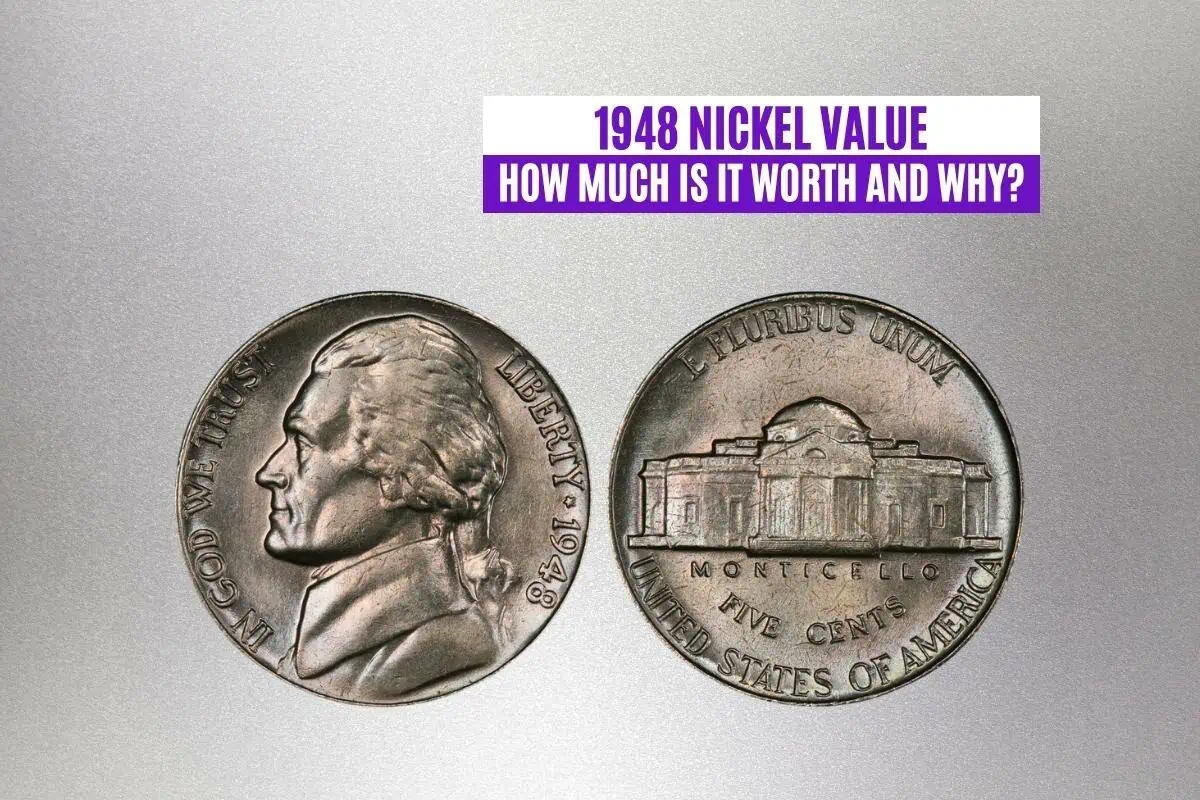The 1948 Jefferson nickel was the eleventh iteration of the now-iconic silver-colored coin. Though it looks nearly identical to all nickels struck between 1938 and 2003, it’s far different from those produced today.
Not only are several 1948 nickels worth far more than their listed denomination ($0.05), but their metal composition differs significantly from modern nickels. But what is the 1948 nickel value?
The answer varies depending on the coin condition (grade) and mint mark. In this guide, we’ll perform an in-depth comparison to help you determine just how much your 1948 Jefferson nickels are worth.
1948 Jefferson Nickel Value Chart
| Variety | MS-65 | MS-66 | MS-67 |
| 1948-P Nickel | $13.5 | $47.25 | $1,620 |
| 1948-P Nickel FS | $88 | $910 | $2,500 |
| 1948-D Nickel | $10.8 | $29.7 | $247 |
| 1948-D Nickel FS | $29.7 | $74 | $455 |
| 1948-S Nickel | $9.45 | $24.3 | $214 |
| 1948-S Nickel FS | $29.7 | $162 | $1,020 |
1948 Jefferson Nickel: History
The five-cent coin (half dime) was one of the earliest coins introduced in the United States in 1792, pre-dating the dime and quarter by four years. The American Civil War caused economic hardship and drove gold and silver from circulation. In response, Congress authorized a five-cent piece (Shield nickel) consisting of base metal, and the Mint began striking this version in 1866.
By the time the 1948 Jefferson nickel came about, the five-cent coin was no longer made of silver. It also didn’t bear the image of a lady with flowing hair or an austere shield, as seen with previous five-cent coins.
Instead, the 1948 nickel showed the image of Thomas Jefferson, the third President of the United States of America. As with the Washington quarter, the Jefferson nickel became one of the longest-lived coin designs in the history of U.S. coinage.
1948 Jefferson Nickel: Design
The Jefferson nickel officially replaced the Buffalo nickel in 1938. From its inception to 1948 (and up until 2003), the design for this coin saw virtually zero changes.
Unlike many coin designs, which were commissioned from celebrated sculptors by higher-ups at the U.S. Mint or high-ranking government officials, the Jefferson nickel design stemmed from a public competition. The winner of this competition was a German-American sculptor named Felix Schlag.
Still, U.S. Mint officials didn’t accept Schlag’s design as-is. Instead, they requested a few changes, including removing a palm tree from the reverse side (the side showing Jefferson’s Monticello plantation house).
But for all intents and purposes, the design seen on the 1948 Jefferson nickel is Schlag’s creation. However, unlike other famous U.S. coin designs, you won’t find Schlag’s initials anywhere on the 1948 nickel.
1948 Jefferson Nickel Obverse
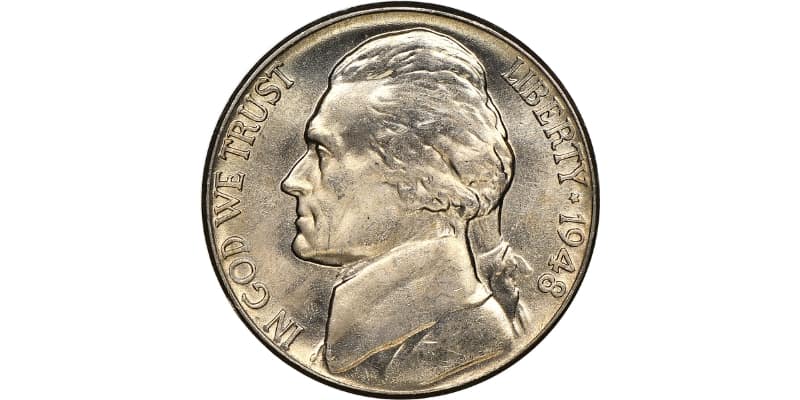
While looking at the obverse (front) side of the 1948 Jefferson nickel, you’ll see:
- The device (raised image) of Thomas Jefferson on the center of the coin, face in profile looking left
- The motto “IN GOD WE TRUST” on the left side of the coin, vertical
- The legend “LIBERTY” on the right side of the coin, verticle
- The year date (1948) displayed vertically on the right side of the coin, separated from the legend (LIBERTY) by a small star
1948 Jefferson Nickel Reverse
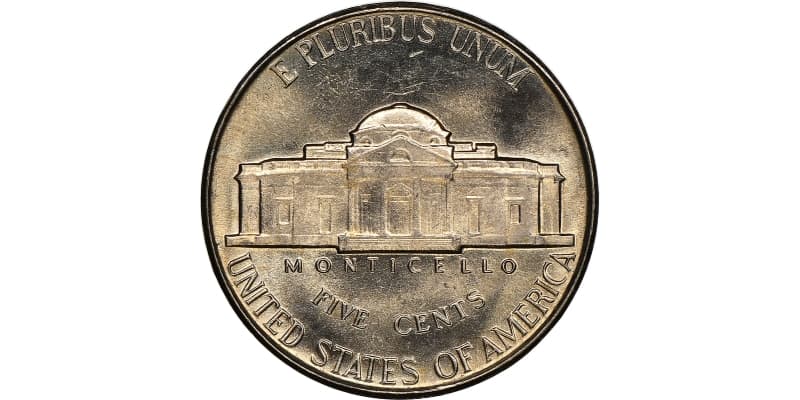
While looking at the reverse (back) side of the 1948 Jefferson nickel, you’ll see:
- The motto “E PLURIBUS UNUM” at the top of the coin
- The device (raised image) of Jefferson’s Monticello property on the center of the coin, “MONTICELLO” spelled out beneath it
- The coin denomination “FIVE CENTS” beneath the device, curving upward
- The issuing nation “UNITED STATES OF AMERICA” at the bottom of the coin, beneath the coin denomination, curving upward
1948 Jefferson Nickel: Features and Specifications
The Jefferson nickel design isn’t the only feature that 1948 nickels have in common. In fact, one of the only qualities separating these coins (apart from their condition) is the mint mark found on their reverse sides.
Otherwise, these coins are essentially identical in terms of size, weight, and metal composition. For example, all 1948 Jefferson nickels (regardless of where they were struck):
- Made of 25% nickel and 75% copper
- Have plain (smooth) edges
- Are 21.2 millimeters (about 0.83 inches) in diameter
- Weight 5 grams (about 0.17 ounces)
How Much Is a 1948 Jefferson Nickel Worth?
According to the CPG values derived from Greysheet, a 1948 No Mint Mark Jefferson nickel in circulated condition is worth between $0.5 and $1.05. It can be worth $1.1 to $1,620 or more in uncirculated condition.
1948 Jefferson Nickel: Value Comparison
The U.S. Mint produced just over 145 million Jefferson nickels in 1948. While that might seem like a high mintage volume, it was the lowest nickel output since 1939, making the 1948 nickel comparatively rare.
That said, about 80% of all nickels struck in 1948 have survived to the modern day. For this reason, 1948 Jefferson nickels aren’t as valuable as less common coins, including the highly coveted 1942-1945 silver Jefferson nickels.
When determining the value of a 1948 Jefferson nickel, there are three factors to consider:
- Coin condition (PCGS or NGC grade)
- The mint mark (No Mint Mark, D, or S)
- Design elements (Full Step reverse)
1948 Jefferson nickels that have been heavily circulated tend to have the lowest estimated values, while those in uncirculated condition (grade MS-60 or higher) tend to be the most valuable. The presence or lack of the Full Step design on the coin’s reverse side also impacts this coin’s value.
The Full Step design refers to the number of steps visible in the image of Monticello. Heavily circulated coins often have fewer visible steps, as this design element easily wears smooth when coins see heavy use.
Coins showing five to six steps (each divided cleanly, with no smooth overlapping between them) are Full Step (or Full Steps) nickels. These coins are almost always in uncirculated condition, and their relative rarity makes them a treasure for any coin collector, albeit a pricey one.
1948 No Mint Mark Jefferson Nickel Value
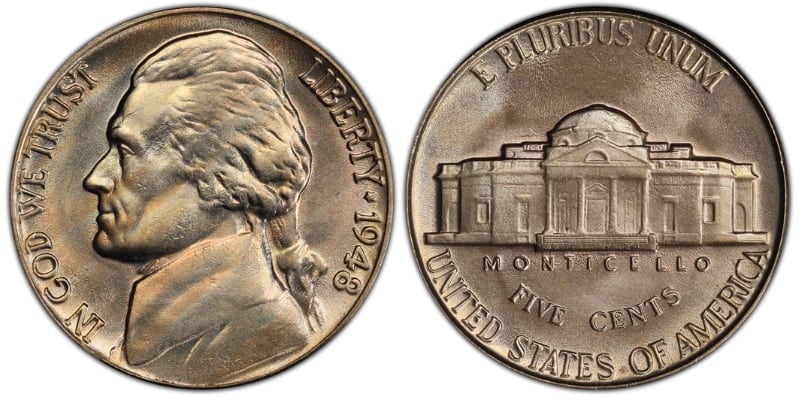
The 1948 No Mint Mark Jefferson nickel (also called the 1948-P Jefferson nickel) hails from the oldest of the U.S. Mint facilities, the Philadelphia Mint.
The Philadelphia Mint struck more than 89 million nickels in 1948, more than the Denver Mint and San Francisco Mint combined! As such, 1948 Jefferson nickels that lack a mint mark are far more common than those with a small “D” or “S” mint mark.
About 71.5 million of these five-cent coins are believed to exist today, and they range in value between $0.5 (XF-40) and $1,620 (MS-67). 1948 No Mint Mark nickels in about uncirculated condition (AU-50) are worth about $0.75.
That said, a Full Step (FS) No Mint Mark Jefferson nickel from 1948 is far more valuable.
Full Step
1948 No Mint Mark Jefferson nickels with the Full Step reverse are only found in uncirculated condition. With a coin grade of MS-63, these nickels are worth about $29.70. But those with a grade of MS-67 have an estimated value of $2,500.
No other 1948 Jefferson has a higher CPG value than this coin! This is likely because most 1948 No Mint Mark nickels were heavily circulated, resulting in only a precious few retaining the Full Step design.
In fact, it’s believed that only about 57,500 FS 1948 No Mint Mark nickels exist (across all coin grades).
1948-D Jefferson Nickel Value
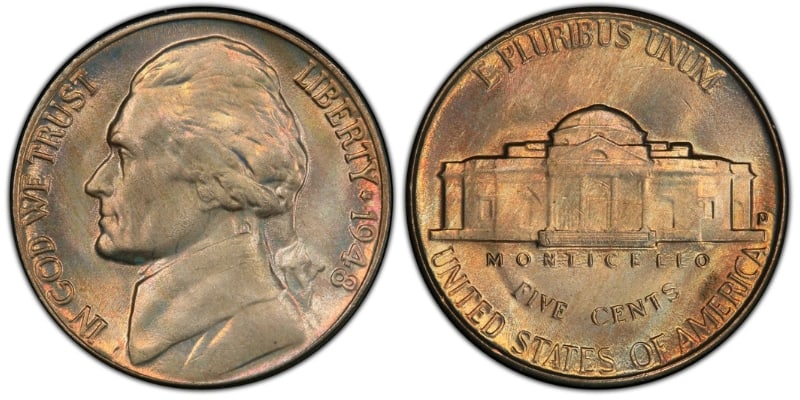
The Denver Mint produced the second-largest volume of Jefferson nickels in 1948, striking 44.734 million five-cent coins. You can identify these coins by the small capital “D” on their reverse sides.
The value of a non-FS 1948-D Jefferson nickel starts at about $0.6 (XF-40). In about uncirculated (AU-50) condition, this coin has an estimated value of $1.50. In uncirculated condition, a 1948-D nickel is worth between $2.65 (MS-60) and $246 (MS-67).
Like other nickels struck in 1948, the Full Step (FS) variety is more valuable.
Full Step
The FS 1948-D Jefferson nickel is worth between $14.85 (MS-64) and $455 (MS-67). Overall, these Full Step 1948 nickels aren’t as valuable as the No Mint Mark ones.
The greater coin population of this variety (247,000 across all grades) contributes to this lower value. In short, the FS 1948-D nickel isn’t quite as rare as Full Step nickels struck at the Philadelphia Mint in 1948.
1948-S Jefferson Nickel Value
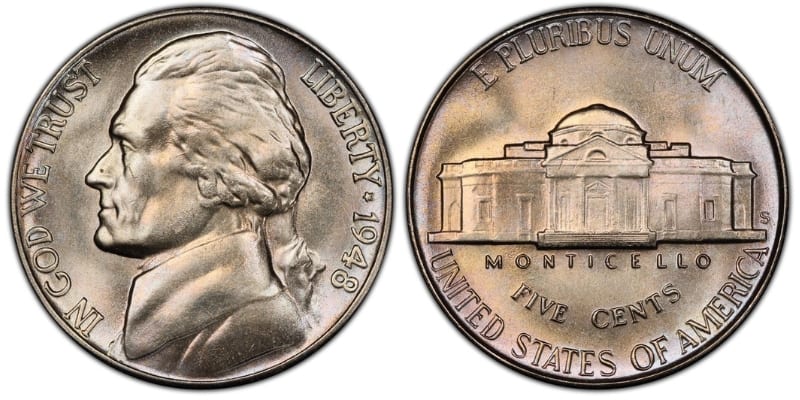
Of all the U.S. Mint facilities tasked with producing Jefferson nickels in 1948, the San Francisco Mint struck the lowest amount; about 11 million. On the surface, this makes the “S” mint mark 1948 nickel somewhat rare, especially when compared to the No Mint Mark and 1948-D varieties.
Still, the value of a non-FS 1948-S Jefferson nickel starts at $0.4 (XF-40). In about uncirculated (AU-50) condition, this five-cent coin is worth about $0.75. This puts it on par with circulated No Mint Mark nickels from 1948.
In uncirculated condition (MS-60 or higher), this coin is worth between $1.90 and $214. Although the mintage for the 1948-S nickel is comparatively low, most nickels struck at the San Francisco Mint survive today, making it slightly less scarce.
Full Step
An FS 1948-S Jefferson nickel is worth between $16.20 (MS-64) and $1,020 (MS-67). Only about 173,000 of these nickels exist today, making them more common than FS No Mint Mark nickels but rarer than FS 1948-D nickels.
1948 Jefferson Nickel: Rare Errors
Although most nickels that entered circulation in 1948 were error-free, some suffered from striking and lamination mistakes. These coins, called error coins, can be more valuable than non-error 1948 Jefferson nickels.
Consequently, investing in nickel error coins could be a fantastic way for coin collectors to boost the value of their collection while also diversifying their pieces! Still, finding and obtaining high-value error coins is challenging if you’re not sure what you’re looking for.
To ensure you choose the best error coins for your collection, let’s briefly touch on three types of 1948 Jefferson nickel errors to look for.
1948 Jefferson Nickel Off-Center Error
All U.S. coins start as blank pieces of metal.
These circular pieces are called planchets or blanks. They only become coins after undergoing the striking process, during which they’re squeezed between two hard metal coin dies.
A coin die is like a stamp, with a recessed engraving that creates a coin image when pressed against a planchet (using a significant amount of pressure). Planchets are squeezed between two coin dies, one engraved with obverse image and the other with the reverse design, giving them their recognizable design features.
However, sometimes a blank planchet isn’t lined up perfectly between the dies during the striking process. When this happens, the resulting coin can have an image that’s off-center. This type of error coin typically shows a sliver of the original “blank” and a design that’s only partially present.
The value of an off-center error coin varies significantly depending on how off-center the design is. The degree of the off-center strike is represented by a percentage, with higher-percentage strikes typically being more valuable.
In October 2010, an MS-64 FS 1948-S Jefferson nickel with a 15% off-center error sold at auction for $391. If the off-center strike had been greater, there’s a good chance it would have fetched a much higher price!
1948 Jefferson Nickel Die Crack Error
Although the coin dies used to impress designs into coin planchets are built to last, they’re not impervious to damage. Over time, these stamp-like pieces can develop cracks inside their recessed faces, leading to error coins with noticeable design flaws, most notably raised lines (which show where the metal squeezed into the crack in a coin die).
Die crack errors are seen across nearly every type of coin. 1948 Jefferson nickels with a die crack error typically sell for between $5 and $75. As with other error nickels from 1948, the coin’s condition, design (Full Step or regular), and mint mark influence the ultimate value of one of these coins.
1948 Jefferson Nickel Lamination Error
Despite the name, nickels are purely made of nickel. Instead, they’re made from a combination of metals. For example, 1948 Jefferson nickels are made of copper and nickel.
When combined correctly, these metals remain stable and solid. But occasionally, the metal sheets (used to create coin blanks) arriving at U.S. Mint facilities exhibit a few manufacturing errors, including improperly combined or badly tainted alloys.
These bits of metals often suffer from lamination errors after the coin-striking process.
Lamination errors often resemble die crack errors. However, while most die crack error coins show a single raised line (representing the crack in the coin die), lamination error coins can have much large raised or recessed portions, resulting from the split of metals inside the coin.
A 1948 Jefferson nickel with lamination errors can sell for between $5 and $50, depending on its grade and mint mark. The severity of the damage caused by the lamination error also contributes to the final value of one of these error coins.
Frequently Asked Questions
Would you like to learn more about the 1948 Jefferson nickel? If so, please check out the frequently asked questions below!
How Many 1948 Jefferson Nickels Exist?
It’s believed that approximately 116.777 million 1948 Jefferson nickels exist today. That’s roughly 80.32% of all the nickels struck in 1948. Many other coins struck in the 1940s don’t have such a high survival rate, making the 1948 Jefferson nickel comparatively common.
What’s the Auction Record for a 1948 Jefferson Nickel?
The auction record for a 1948 Jefferson nickel was set in 2021 when an MS-67+ Full Step 1948-S Jefferson nickel sold at auction for $12,000. No other 1948 Jefferson nickel, non-error or error, has sold for such a high price.
What’s the Rarest 1948 Jefferson Nickel?
According to PCGS coin survival estimates, the rarest 1948 Jefferson nickel is the 1948 No Mint Mark Full Step nickel. It’s thought that only about 57,500 of these coins exist today.
Are There Proof-Strike 1948 Jefferson Nickels?
From 1943 to 1949, the U.S. Mint produced no proof-strike Jefferson nickels. Consequently, you won’t find any 1948 proof-strike nickels available for collection.
Final Thoughts
The Jefferson nickel design has enjoyed the longest lifespan of any five-cent U.S. coin. But while the design for this coin remained consistent between 1938 and 2003, its composition, mintage, and strike types (regular versus proof) varied significantly.
Overall, the most valuable of these five-cent pieces is the 1948 No Mint Mark Full Step nickel. In MS-67 condition, one of these coins can fetch $2,500 or more.
Discover more about coin values by checking out these related articles!

